Centauri Dreams
Imagining and Planning Interstellar Exploration
‘Echoes’ from the Far Side of a Black Hole
The first direct observation of light from behind a black hole has just been described in a paper in Nature. What is striking in this work is not so much the confirmation, yet again, of Einstein’s General Relativity, but the fact that we can observe the effect in action in this environment. Having just read Heino Falcke’s Light in the Darkness: Black Holes, the Universe, and Us (HarperOne 2021), I have been thinking a lot about observing what was once thought unobservable, as Falcke and the worldwide interferometric effort called the Event Horizon Telescope managed to do when they produced the first image of a black hole.
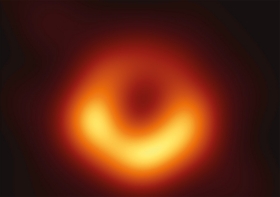
The famous image out of that work that went worldwide in the media was of the supermassive black hole at the center of the galaxy M87, while the new paper — which offers no image but rather data on telltale X-ray emissions — covers a galaxy called I Zwicky 1 (I Zw 1), a Seyfert galaxy 800 million light years from the Sun. These are active galaxies with supermassive black holes at their centers and quasar-like nuclei. The data on this one were drawn from observations of I Zw 1 in early 2020 by the X-ray telescopes NuSTAR and XMM-Newton.
Image: The image of the black hole at the center of M87 shows the effect of the accretion disc as well as the black hole’s shadow. Credit: Akiyama et al. and ApJL.
Dan Wilkins, lead author of the paper on this work in Nature, is a research scientist at the Kavli Institute for Particle Astrophysics and Cosmology at Stanford and SLAC National Accelerator Laboratory. He explains how the malleability of spacetime makes the observations of I Zw 1’s black hole possible:
“Any light that goes into that black hole doesn’t come out, so we shouldn’t be able to see anything that’s behind the black hole. The reason we can see that is because that black hole is warping space, bending light and twisting magnetic fields around itself.”
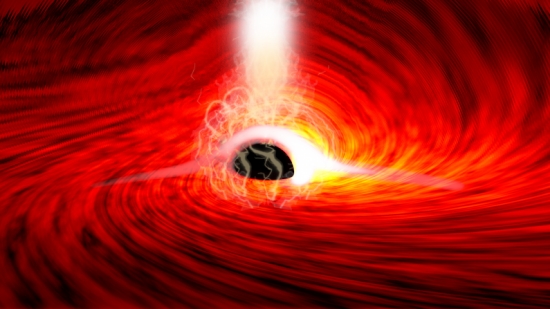
Image: Researchers observed bright flares of X-ray emissions, produced as gas falls into a supermassive black hole. The flares echoed off of the gas falling into the black hole, and as the flares were subsiding, short flashes of X-rays were seen – corresponding to the reflection of the flares from the far side of the disk, bent around the black hole by its strong gravitational field. Credit: Dan Wilkins.
Material moving in the innermost regions of the accretion disk around a supermassive black hole forms a compact and variable corona of X-ray light near the object that allows scientists to map and characterize the accretion disk. Here superheated gas creates a magnetized plasma caught in the black hole’s spin. The magnetic field twists around itself, eventually breaking. The X-rays are reflected from the accretion disk, which gives us a look at events just outside the black hole’s event horizon.
All of this fits current thinking about how the black hole corona forms, but the researchers then detected a series of smaller X-ray flashes, reflections from the inner part of the accretion disk with calculable reverberation time delays. Wilkins calls these ‘echoes’ because they are the same X-ray flares but reflected from the back of the disk. In essence, this gives us the first information we have to characterize the far side of a black hole, and follows from Wilkins’ earlier research. The scientist adds:
“This magnetic field getting tied up and then snapping close to the black hole heats everything around it and produces these high energy electrons that then go on to produce the X-rays. I’ve been building theoretical predictions of how these echoes appear to us for a few years. I’d already seen them in the theory I’ve been developing, so once I saw them in the telescope observations, I could figure out the connection.”
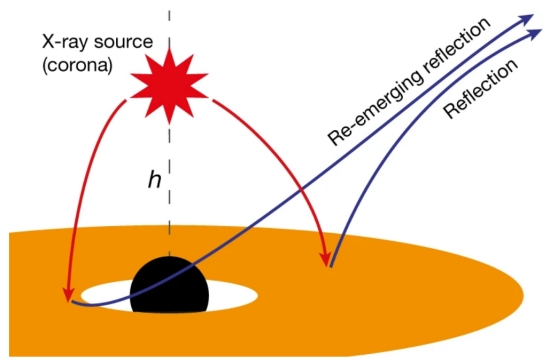
Image: This is Figure 2 from the paper, labelled “Schematic of the X-ray reverberation model.” Caption: X-rays are emitted from a corona of energetic particles close to the black hole. Some of these rays reach the observer directly, but some illuminate the inner regions of the accretion disk and are observed reflected from the disk. Strong light bending in the gravitational field around the black hole focuses the rays towards the black hole and onto the inner regions of the disk. Rays reflected from the back of the disk can be bent around the (spinning) black hole, allowing the re-emergence of X-rays from parts of the disk that would classically be hidden behind the black hole. Credit: Wilkins et al.
What I find extraordinary is that we are getting a glimpse of the accretion disk at work to a fine level of detail. The flares in this black hole’s corona “reveal the temporal response of the illuminated accretion disk,” as the paper puts it, going on to explain the strong Doppler effects at play here:
Emission line photons from different parts of the disk experience different Doppler shifts, due to the variation in the line-of-sight velocity across the disk, and also experience gravitational redshifts, which increase closer to the black hole. The energy shifts of the line photons therefore contain information about the positions on the accretion disk from which they were emitted. The light travel time varies according to the distance of each part of the disk from the corona, and the line emission at different energy shifts is expected to respond to the flare at different times.
Data from the coronal flares and their reverberations allow the team to measure the height of the X-ray source above the disk and also to measure the mass of the black hole itself, which turns out to be on the order of 30 million solar masses. The authors go into detail about the factors at play in the mass estimate, and as the paper is available online, I’ll leave that analysis for those interested in following it up themselves.
Once again black holes provide a way of seeing what had been thought unobservable. Co-author Roger Blandford, also at Stanford, takes note of how far we’ve come:
“Fifty years ago, when astrophysicists started speculating about how the magnetic field might behave close to a black hole, they had no idea that one day we might have the techniques to observe this directly and see Einstein’s general theory of relativity in action.”
Pushing yet deeper will be the European Space Agency’s X-ray observatory Athena (Advanced Telescope for High-ENergy Astrophysics). Wilkins is part of the team developing the Wide Field Imager detector for the telescope, scheduled for launch in 2031.
The paper is Wilkins et al., “Light bending and X-ray echoes from behind a supermassive black hole,” Nature 595 (2021), 657-660 (abstract).

Sublimation Producing Water Vapor on Ganymede
Hubble observations from the past two decades have been recently re-examined as a way of investigating what is happening in the tenuous atmosphere of Ganymede, the largest moon in the Solar System. It was in 1998 that the telescope’s Space Telescope Imaging Spectrograph took the first images of Ganymede at ultraviolet wavelengths, showing auroral bands — ribbons of electrified gas — that reinforced earlier evidence that the moon had a weak magnetic field. Now we have news of sublimated water vapor within the atmosphere, an earlier prediction now verified.
Ganymede’s atmosphere, such as it is, is the result of charged particles and solar radiation eroding its icy surface, producing both molecular (02) and atomic oxygen (0) as well as H20, with the molecular oxygen long thought to be the most abundant constituent overall. Surface temperatures are as extreme as you would expect, roughly between 80 K and 150 K (-193 °C to -123 °C).
In 2018, a team led by Lorenz Roth (KTH Royal Institute of Technology in Stockholm) again turned to Hubble, this time in support of the ongoing Juno mission. The goal was to measure Ganymede’s atomic oxygen (0) as a way of resolving differences in the 1998 ultraviolet observations, which were thought to be the result of higher concentrations of atomic oxygen in some parts of the atmosphere. The result was surprising.
Roth’s team used data from Hubble’s Cosmic Origins Spectrograph along with archival data from the Space Telescope Imaging Spectrograph taken in 1998 and 2010. There was little trace of atomic oxygen in Ganymede’s atmosphere, meaning that differences in the auroral images must have some other explanation. The relative distribution of the aurorae allowed the scientists to map them against projected water sources on the surface, released when the moon sublimates water molecules as the equator warms. The phenomenon has no connection with the moon’s subsurface ocean, thought to be buried 150 kilometers beneath the surface.
The fit is strong: The area where water vapor would be expected in Ganymede’s atmosphere, around noon at the equator, correlates with the differences in the ultraviolet images. Roth thinks water vapor produced by sublimation (ice turning directly to vapor with no intervening liquid state) is the explanation:
“So far only the molecular oxygen had been observed,. This is produced when charged particles erode the ice surface. The water vapor that we measured now originates from ice sublimation caused by the thermal escape of water vapor from warm icy regions.”
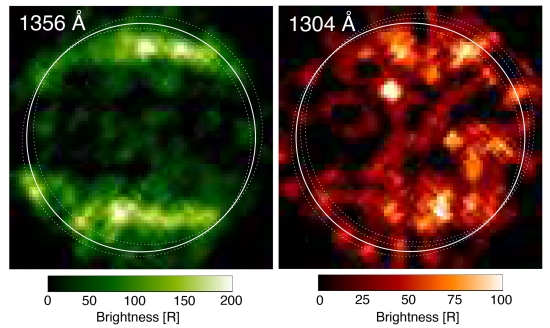
Image: In 1998, Hubble’s Space Telescope Imaging Spectrograph took these first ultraviolet images of Ganymede, which revealed a particular pattern in the observed emissions from the moon’s atmosphere. The moon displays auroral bands that are somewhat similar to aurora ovals observed on Earth and other planets with magnetic fields. This was illustrative evidence for the fact that Ganymede has a permanent magnetic field. The similarities in the ultraviolet observations were explained by the presence of molecular oxygen. The differences were explained at the time by the presence of atomic oxygen, which produces a signal that affects one UV color more than the other. Credit: NASA, ESA, Lorenz Roth (KTH).
The paper goes on to point out the significance of the observation (italics mine):
The low oxygen emission ratios in the center of Ganymede’s observed hemispheres are consistent with a locally H2O-dominated atmosphere. With phase angles around 10? …the disk centers are close to the sub-solar points…. A viable source for H2O in Ganymede’s atmosphere can be sublimation in the low-latitude sub-solar regions, where an H2O-dominated atmosphere was indeed predicted by atmosphere models. Our derived H2O mixing ratios are in agreement with these predictions. While previously detected tenuous atmospheres around icy moons in the outer solar system were consistent with surface sputtering (or active outgassing) as source for the neutrals our analysis provides the first evidence for a sublimated atmosphere on an icy moon in the outer solar system.
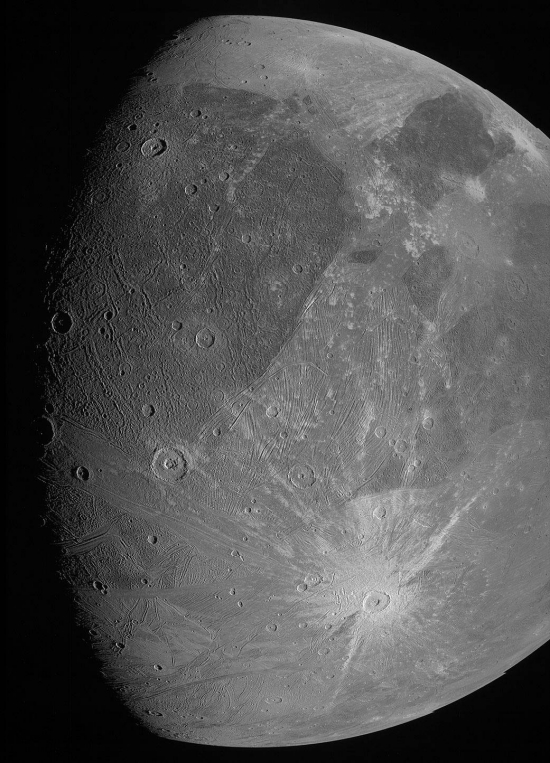
Image: This image of the Jovian moon Ganymede was obtained by the JunoCam imager aboard NASA’s Juno spacecraft during its June 7, 2021, flyby of the icy moon. At the time of closest approach, Juno was within 1,038 kilometers of its surface – closer to Jupiter’s largest moon than any other spacecraft has come in more than two decades. Credit: NASA/JPL-Caltech/SwRI/MSSS.
So we have an atmosphere with what the paper describes as “a pronounced day/night asymmetry.” It’s an important finding for future missions, for atmospheric asymmetries will turn up in data on the magnetosphere and space plasma, meaning numerical simulations and data analysis for future missions have to incorporate them. This points to JUICE, the Jupiter Icy Moons Explorer mission, which will put eleven science instruments past Ganymede in a series of flybys and later orbital operations.
That itself is a stunning thought to someone who grew up thinking about Ganymede as a Poul Anderson novel setting. We’ll have a spacecraft orbiting the moon for a minimum of 280 days, if all goes according to plan, giving scientists abundant data about both the surface and atmosphere. The Roth paper provides significant information about the role of sublimation that will refine the JUICE observing plan.
The paper is Roth et al., “A sublimated water atmosphere on Ganymede detected from Hubble Space Telescope observations,” Nature Astronomy 26 July 2021 (abstract / preprint).

A Path to Planet Formation in Binary Systems
How planets grow in double-star systems has always held a particular fascination for me. The reason is probably obvious: In my younger days, when no exoplanets had been discovered, the question of what kind of planetary systems were possible around multiple stars was wide open. And there was Alpha Centauri in our southern skies, taunting us by its very presence. Could a life-laden planet be right next door?
What Kedron Silsbee and Roman Rafikov have been working on extends well beyond Alpha Centauri, usefully enough, and helps us look into how binaries like Centauri A and B form planets. Says Rafikov (University of Cambridge), “A system like this would be the equivalent of a second Sun where Uranus is, which would have made our own solar system look very different.” How true. In fact, imagining how different our system would work if we had a star among the outer planets raises wonderful questions.
Could we have a habitable world around each star in such a binary? And if so, wouldn’t the incentive to develop spaceflight take hold early among the denizens of such a world? We used to imagine a habitable Mars, by stretching Percival Lowell’s observations of what Giovanni Schiaparelli described as ‘canali’ (‘channels’) to their limit. How much more would a green and blue world with clouds and oceans beckon?
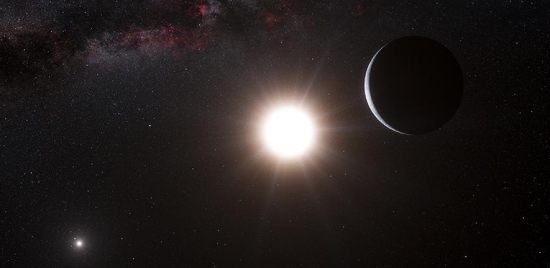
Image: Artist’s impression of a hypothetical planet around Alpha Centauri B. Credit: ESO/L. Calçada/N. Risinger.
But back to Rafikov, whose paper with Silsbee (Max Planck Institute for Extraterrestrial Physics) has been accepted at Astronomy & Astrophysics. The two researchers have refined binary star planet formation through a series of simulations, with Alpha Centauri in mind as well as the tight binary Gamma Cephei, a K-class star with red dwarf companion and a planet orbiting the primary. Silsbee explains the problem they were trying to solve: How does the companion star affect the existing protoplanetary disk of the other? He adds:
“In a system with a single star the particles in the disc are moving at low velocities, so they easily stick together when they collide, allowing them to grow. But because of the gravitational ‘eggbeater’ effect of the companion star in a binary system, the solid particles there collide with each other at much higher velocity. So, when they collide, they destroy each other.”
Gamma Cephei is a case in point: The system yields planetesimal collision velocities of several kilometers per second at the 2 AU distance of the system’s known planet, which should be enough, the authors note, to destroy even planetesimals as large as hundreds of kilometers in size. This problem appears in the literature as the fragmentation barrier, and it looms large, even when taking into account the aerodynamic drag induced by the gases of the protoplanetary disk. We can expect high collision velocities here.
And there go the planetesimals, which should, according to core accretion theory, grow out of dust particles as they gradually begin to bulk up into larger solid bodies. Given that we now know about numerous exoplanets in binary systems, how did they emerge? Were they all ‘rogue’ planets that ambled into the gravitational influence of the binary pair? And if that idea seems unlikely, how then do we explain their growth?
Rafikov and Silsbee show through their simulations that given realistic processes and the mathematics to describe them, such worlds will emerge. Incorporated in the resulting model is a new look at the question of gas drag and its effects. They find that drag in the disk — Silsbee likens it to a kind of wind — can indeed alter planetesimal dynamics and can offset the gravitational influence of the nearby stellar companion.
For although a number of earlier studies included gas drag in their models, their calculations ignored the effect of disk gravity, which according to the authors changes the dynamics of the population of planetesimals. They are able to identify quiet zones in the disk in which planetesimals can grow into planets. And they believe their model fully accounts for planetesimal dynamics throughout the young system. Among their conclusions:
The gravitational effect of the protoplanetary disk plays the key role in lowering the minimum initial planetesimal size necessary for sustained growth by a factor of four. This reduction can be achieved in protoplanetary disks apsidally aligned with the binary, in which a dynamically quiet zone appears within the disk provided that the mass-weighted mean disk eccentricity ≲ 0.05…
And this:
For most disk parameters considered in this paper, planet formation in binaries such as γ Cephei can successfully occur provided that the initial planetesimal size is ≲ 10 km; however, for favorable disk parameters, this minimum initial size can go down to ≲ 1 km.
We should expect, then, that planets could form in systems like Alpha Centauri, where the hunt for worlds around the Centauri A and B pair continues. This can occur if the planetesimals can reach this minimum size, and it assumes a protoplanetary disk that is close to circular. Given those parameters, planetesimal relative velocities are slow enough in certain parts of the disk to allow planet formation to take place.
How to get planetesimals to the minimum size needed? The streaming instability model of planetesimal formation may be operational here, in which the planetesimals grow rapidly. In this model, drag in the disk slows solid particles and leads to their swift agglomeration into clumps that can gravitationally collapse. Streaming instability is a rapid alternative to the alternate theory of planetesimals growing steadily through coagulation alone. In fact, the paper cites a timescale of tens of local orbital periods, rapidly producing a population of ‘seed’ planetesimals.
Whether or not streaming instability does offer a pathway to planets is a question that is still unresolved, though the theory has implications for planet formation around single stars as well. It certainly eases formation in the binaries considered here.
The paper is Silsbee & Rafikov, “Planet Formation in Stellar Binaries: Global Simulations of Planetesimal Growth,” accepted at Astronomy and Astrophysics (abstract / preprint).

The Case of PDS 70 and a Moon-forming Disk
The things we look for around other stars do not necessarily surprise us. I think most astronomers were thinking we’d find planets around a lot of stars when the Kepler mission began its work. The question was how many — Kepler was to give us a statistical measurement on the planet population within its field of stars, and it succeeded brilliantly. These days it seems clear that we can find planets around most stars, in all kinds of sizes and orbits, as we continue to seek an Earth 2.0..
The continuing news about the star PDS 70, a young T Tauri star about 400 light years away in Centaurus, fits the same mold. Here we’re talking not just about planets but their moons. No exomoons have been confirmed, but there seems no reason to assume we won’t begin to find them — surely the process of forming moons is as universal as that of planet formation. The interest is in the observation, how it is made, and what it implies about our ability to move forward in characterizing planetary systems.
The process takes time, and results can be ambiguous. Back in 2019, PDS 70 was the subject of work performed at Monash University (Australia), led by Valentin Christiaens. The story received an exomoon splash in the press: The researchers believed they were looking at a circumplanetary disk around one of two gas giants forming in this system (see Exoplanet Moons in Formation?).
Everything pointed to a moon-forming disk around one of two young gas giants in the system, though the conclusion could only be considered tentative. I want to mention this because work from the European Southern Observatory that we’ll discuss today also finds a circumplanetary disk at PDS 70, though not around the same still-forming planet examined in the Christiaens et al. study. What an intriguing system this is!
While Christiaens and team looked at PDS 70b, the ESO work examines new high-resolution images of the second gas giant, PDS 70c, using data obtained through the Atacama Large Millimetre/submillimetre Array (ALMA). Led by Myriam Benisty (University of Grenoble and University of Chile), the international team now declares the detection of a circumplanetary disk — though not yet a moon — unambiguous. Says Benisty:
“Our work presents a clear detection of a disk in which satellites could be forming. Our ALMA observations were obtained at such exquisite resolution that we could clearly identify that the disk is associated with the planet and we are able to constrain its size for the first time.”
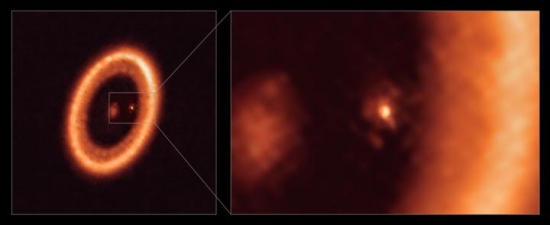
Image: This image shows wide (left) and close-up (right) views of the moon-forming disk surrounding PDS 70c, a young Jupiter-like planet nearly 400 light-years away. The close-up view shows PDS 70c and its circumplanetary disk center-front, with the larger circumstellar ring-like disk taking up most of the right-hand side of the image. The star PDS 70 is at the center of the wide-view image on the left. Two planets have been found in the system, PDS 70c and PDS 70b, the latter not being visible in this image. They have carved a cavity in the circumstellar disk as they gobbled up material from the disk itself, growing in size. In this process, PDS 70c acquired its own circumplanetary disk, which contributes to the growth of the planet and where moons can form. This disk is as large as the Sun-Earth distance and has enough mass to form up to three satellites the size of the Moon. Credit: ALMA (ESO/NAOJ/NRAO)/Benisty et al.
The high-resolution data allow Benisty and team to state that the circumplanetary disk has a diameter of about 1 AU, with enough mass to form up to three moons the size of our own Moon. The planetary system forming around this star is reminiscent of the Jupiter and Saturn configuration in our own Solar System, though notice the size differential. The disk around PDS 70c is 500 times larger than Saturn’s rings. The two planets are also at much larger distances from the host star, and appear to be migrating inward. We are seeing the system in the process of formation, which should offer insights into how not just moons but planets themselves form around infant stars.
Interestingly, the second world here, PDS 70b, does not show evidence of a circumplanetary disk in the ALMA data. One supposition is that it is being starved of dusty material by PDS 70c, although other mechanisms are possible. Here’s a bit more on this from the paper, noting an apparent transport mechanism between disk and forming planet:
These ALMA observations shed new light on the origin of the mm emission close to planet b. The emission is diffuse with a low surface brightness and is suggestive of a streamer of material connecting the planets to the inner disk, providing insights into the transport of material through a cavity generated by two massive planets.
And as to PDS 70b:
The non-detection of a point source around PDS 70 b indicates a smaller and/or less massive CPD [circumplanetary disk] around planet b as compared to planet c, due to the filtering of dust grains by planet c preventing large amount of dust to leak through the cavity, or that the nature of the two CPDs differ. We also detect a faint inner disk emission that could be reproduced with small 1 µm dust grains, and resolve the outer disk into two substructures (a bright ring and an inner shoulder).
The Monash University team in Australia was able to image PDS 70b in the infrared and, like the ESO astronomers, was able to find a spiral arm seeming to feed a circumplanetary disk, while making the case for PDS 70b as the world with the disk. Remember that the two teams were working with different instrumentation and at different wavelengths — the Monash researchers operated at infrared wavelengths to analyze the spectrum of the planet produced by SINFONI (Spectrograph for INtegral Field Observations in the Near Infrared) at the Very Large Telescope in Chile. The ESO team used data from ALMA.
So do we have one or two circumplanetary disks in this system? We’ll see how this is resolved as the investigation of the planets around PDS 70 continues through a variety of instruments. For the importance of the system is clear, as the Benisty paper argues:
Detailed studies of the circumplanetary disks, and of the leakage of material through the cavity, will provide strong constraints on the formation of satellites around gas giants, and on the ability to provide the mass reservoir needed to form terrestrial planets in the inner regions of the disk. Upcoming studies of the gas kinematics and chemistry of PDS 70 will complement the view provided by this work, serving as a benchmark for models of satellite formation, planet-disk interactions and delivery of chemically enriched material to planetary atmospheres.
The paper is Benisty et al., “A Circumplanetary Disk around PDS70c,” Astrophysical Journal Letters Vol. 916, No. 1 (22 July 2021). Abstract.

Voice of the (SF) Master: Stanislaw Lem and the Philosophy of SETI
Milan M. ?irkovi?’s work has been frequently discussed on Centauri Dreams, as a glance in the archives will show. My own fascination with SETI and the implications of what has been called ‘the Fermi question’ led me early on to his papers, which explore the theoretical, cultural and philosophical space in which SETI proceeds. And there are few books in which I have put more annotations than his 2018 title The Great Silence: The Science and Philosophy of Fermi’s Paradox (Oxford University Press). Today Dr. ?irkovi? celebrates Stanislaw Lem, an author I first discovered way back in grad school and continue to admire today. A research professor at the Astronomical Observatory of Belgrade, (Serbia), ?irkovi? obtained his PhD at the Dept. of Physics, State University of New York in Stony Brook in 2000 with a thesis in astrophysical cosmology. He tells me his primary research interests are in the fields of astrobiology (habitable zones, habitability of galaxies, SETI studies), philosophy of science (futures studies, philosophy of cosmology), and risk analysis (global catastrophes, observation selection effects and the epistemology of risk). He co-edited the widely-cited anthology Global Catastrophic Risks (Oxford University Press, 2008) with Nick Bostrom, has published three research monographs and four popular science/general nonfiction books, and has authored about 200 research and professional papers.
by Milan ?irkovi?

This year we celebrate a centennial of the birth of a truly great author and thinker who is still, unfortunately, insufficiently well-known and read. Stanislaw Lem was born in 1921 in then Lwów, Poland (now Lviv, Ukraine). That was the year ?apek’s revolutionary drama R.U.R. premiered in Prague’s National Theatre and defined the word “robot”, Albert Einstein was awarded the Nobel Prize in physics for his work on the photoelectric effect in the course of which he effectively discovered photons, and one Adolf Hitler became the leader of a small far-right political party in Weimar Germany.
All three of these central-European developments have exerted a strong influence on Lem’s life and career. His studies of medicine, inspired by both his father’s distinguished medical career and his early-acquired mechanistic view of human beings, have been interrupted three times due to the chaos of WW2 and post-war changes. He narrowly escaped being executed by German authorities during the war for his resistance work. Finally, when he was on the verge of acquiring a diploma at the famous Jagiellonian University of Krakow, in 1949, he abandoned the pursuit in order to avoid the compulsory draft to which physicians were susceptible in the new communist Poland. He did some practical medical work in a maternity ward, but very quickly left medicine for good and became a full-time writer.

The apex of Lem’s creative career spans about three decades, from The Investigation published in 1958, to the publication of Fiasco and Peace on Earth in 1987. During that period, he published his greatest novels, in particular Solaris (1961), The Invincible (1966), His Master’s Voice (1968), and The Chain of Chance (1976), along with numerous short story anthologies, the most important being The Cyberiad (1965), as well as the Ijon Tichy and Pilot Pirx story cycles.
Image: Polish science fiction writer Stanislaw Lem. Credit: Wojciech Zemek.
Finally, several works in the Borgesian meta-genre of imaginary forewords, introductions, and book reviews, notably The Perfect Vacuum of 1971. This has been complemented by very extensive non-fiction writing, mainly in several fields of philosophy of science, futures studies, and literary criticism. The last two decades of Lem’s life were characterized by essayistic and publishing activity, as well as receiving innumerable prizes and awards, but no original fiction writing. Lem passed away peacefully on March 27, 2006, at the age of 84 in his home in Krakow.
Lem was obssessed by the theme of Contact: from his very first science-fiction novel, The Astronauts in 1951 (which he himself denounced as “childish”) to the last, great and deeply disturbing Fiasco, which is a kind of literary and philosophical testament. Nowhere, however, is his thought more in touch with the practical aspects of our SETI/search for technosignatures projects as in His Master’s Voice (originally published in 1968, that is only 8 years after the original Ozma Project! Translated into English by Michael Kandel only in 1983).

It is a brilliant work, perhaps the best novel ever written about SETI, but also a dense tract indeed. So, instead of many examples, I shall concentrate upon this one as a case study for the tremendous usefulness of reading Lem for anyone interested in astrobiology/SETI studies.
The study of the motives and ideas relevant for these fields would require a book-length treatment, as is obvious from the list of auxiliary topics Lem masterfully weaves into the narrative: from the ontological status of mathematical objects to the psyche of the Holocaust survivors, from preconditions for abiogenesis to the origin of the arrow of time. It is a challenging text in more than one sense; there is almost no dialogue and no manifest action beyond the recounting of a SETI project that not only failed but was never truly comprehended in the first place.
Image: A 1983 English edition of His Master’s Voice from Harcourt Brace Jovanovich, one of many editions available worldwide.
And this is a book whose plot should not be spoilt, since it is not as widely read as it should be half a century later. Without revealing too much, His Master’s Voice is set at a time when neutrino astrophysics is advanced enough to be able to detect possible modulations (imagined to have occurred near the end of the 20th century in the continued Cold War world). A neutrino signal repeating every 416 hours is discovered from a point in the sky within 1.5° of Alpha Canis Minoris. An eponymous top-secret project is then formed in order to decrypt the extraterrestrial signal, burdened by all the Cold-War paranoia and heavy-handed bureaucracy of the second half of the twentieth century. The project has its ups and downs, including some quite dramatic and literally threatening the survival of human civilization, but it is—obviously—mostly unsuccessful. The protagonist, a mathematical genius and cynic named Peter Hogarth, is neither a hero nor a villain; the SETI plot ends in anticlimactic uncertainty.
An intriguing consequence of Lem’s scenario is a realization that, while detectability generally increases with the progress of our astronomical detector technology, it does so very unevenly, in jumps or bursts. Although the powerful source of the “message” in the novel (presumably an alien beacon) had been present for a billion years or more, it became detectable only after a sophisticated neutrino-detecting hardware was developed. And even then, the detection of the signal happened serendipitously. Thus, in a rational approach to SETI—not often followed in practice, alas—the issue of detectability should be entirely decoupled from the issue of synchronization (the extent to which other intelligent species are contemporary to us).
Fermi’s paradox does not figure explicitly in His Master’s Voice (in contrast to many other of Lem’s works, especially his late and in my opinion equally magnificent Fiasco), and for an apparently obvious reason: “the starry letter” has always been here, or at least long enough on geological timescales. Detectability is, at least in part, a function of historical human development.
And there is a very real possibility, in the context of the plot, that “the letter” does not originate with intentional beings at all. The fulcrum of the book is reached when three radical hypotheses are presented to weary researchers, including the one attributing the signal to purely natural astrophysical processes! But even in this revisionist case, there are other problems, especially in light of the fact that the signal manifests “biophilic” properties: it helps complex biochemical reactions, and scientists in the novel speculate about whether it helped the abiogenesis on Earth. If it did so, the same necessarily occurred on many other planets in the Galaxy, so even if we abstract the mysterious Senders, it is natural to ask: where are our peers? This leads to more severe versions of Fermi’s paradox. In the same time, it makes us think about the various forms directed panspermia could, in fact, take when we reject our anthropocentric thinking.
There is another key lesson. While the discovery of even a single extraterrestrial artefact (and Lem’s neutrino message can surely be regarded as an artefact in the sense of the contemporary search for technosignatures), would be a great step forward, it would not, at least not immediately, resolve the problem. If one could conclude, as some of the protagonists of His Master’s Voice do, that there exist just two civilizations in the Galaxy, us and the mysterious Senders, that would still require explanation. Two is, in this particular context, sufficiently close if not equal to one.
And this shows, finally, the true gift of Lem’s thought to astrobiology and SETI studies: a capacity to go one step beyond in strangeness, to kick us sufficiently strongly out of the grooves of conventional thinking, to disturb us—and offend us, if necessary—and make us reject the comfortable and usual and mundane. In a general sense, all philosophy should do the same for us; that it usually does not is indeed discouraging and depressing. From time to time, however, a thinker passes with a bright torch illuminating the path and indicating how clueless we in fact are.
Lem was just such a figure. Reading him is indeed the highest form of celebration of reason and wisdom.

Radial Velocity: NEID Spectrograph Goes to Work
The NEID spectrograph has passed the Operational Readiness Review necessary for final acceptance and regular operations. Developed by NASA and the National Science Foundation’s NN-EXPLORE exoplanet science program, it has been put through a lengthy commissioning process in the five years since the radial velocity planet hunter design was selected. NEID is mounted on the WIYN 3.5m telescope at Kitt Peak National Observatory in Arizona, and we now have word that its scientific mission has begun.
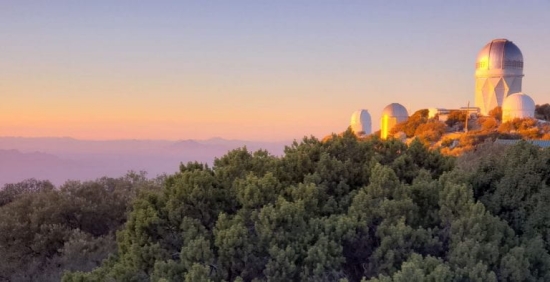
Image: Sunset over Kitt Peak National Observatory during NEID commissioning in January 2020. Credit: Paul Robertson.
As a radial velocity instrument, NEID is all about the tugs one or more planets exert on the host star, as measured radially — toward Earth, then away from it — during the planets’ orbits. The Doppler shift in the star’s light contains the information. That these are exquisitely tiny measurements should be obvious. Jupiter induces a 13 meter per second wobble on our star, but the Earth only manages to induce a wobble of 9 centimeters per second. NEID’s single measurement precision is already better than 25 centimeters per second, making it an excellent addition to the toolkit for finding new worlds.
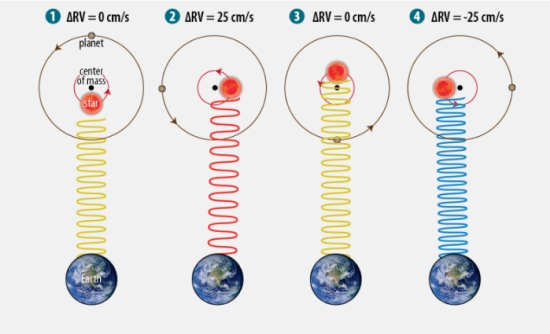
Image: A schematic of the Doppler effect: as the star wobbles under the gravitational influence of its planets, NEID measures the resulting wavelength shifts in its spectrum. Credit: NEID team.
It’s a tribute to the effort behind NEID that the team had to work through COVID-related shutdowns, in essence forcing them to start the commissioning process over, and as the NEID blog notes, for two winters in a row, they had to endure 12-hour nights of observing for up to a week at a time to get the job done. Nice work!
From December of 2020 to April of 2021, a series of experiments tested the reliability of the instrument, its precision and its limitations, making measurements of Doppler-stable stars to analyze the spectrometer’s limiting velocity measurement precision, as recounted in this blog entry by team members, from which this:
What we learned is that across a wide variety of targets, and in a wide variety of conditions, NEID offers radial velocity measurement precision that rivals the best facilities in the world. Our measurements of stable stars consistently show variability less than 1 meter per second. This on-sky stability reflects a combination of noise sources, including the instrument, statistical fluctuations (so-called “photon noise”), and the star’s inherent atmospheric variability. Thus, while it is hard to pin down an exact number, we are assured that NEID’s instrument-limited measurement precision is significantly better than 1 meter per second.
NEID seems on course to complement other high precision spectrographs like HARPS (High Accuracy Radial Velocity Planet Searcher), which is installed at the European Southern Observatory’s 3.6m telescope at La Silla Observatory in Chile, and its successor ESPRESSO (Echelle Spectrograph for Rocky Exoplanet- and Stable Spectroscopic Observations). How far can these instruments push into the centimeters-per-second range, so crucial for finding Earth-class planets?
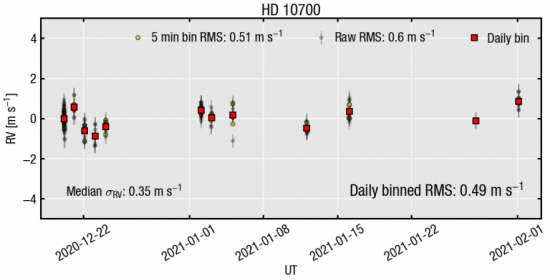
Image: NEID radial velocity measurements of the quiet star tau Ceti. Our on-sky measurements are stable to better than 50 centimeters per second, which indicates the instrument itself is even more stable. Credit: NEID Team.
The NEID team also plans to use a smaller solar telescope in combination with NEID during the day, its express purpose to gather data to produce better machine learning algorithms with which to separate the signal of planets from ‘starspots’ on the target star. These can confound detection efforts by mimicking a planet’s signature. The solar observations will be released publicly to help scientists address the problem, with data processing coordinated by the NASA Exoplanet Science Institute (NExScI) at Caltech/IPAC. The data will be made available through the NEID science archive.
For one direction NEID goes next, we can turn to Andrea Lin (Penn State), who designed and built the solar telescope. Lin explains her own choice of targets:
“The solar telescope was a fun project to work on. I look forward to using NEID for my doctoral dissertation research. One of my planned projects with NEID is to look for planets around K-dwarfs. These stars line up incredibly well with NEID’s capabilities, and the radial velocity method in general, so I’m hoping to discover some small—hopefully terrestrial!—planets around nearby K-stars.”
For further background on NEID, see the Centauri Dreams article New Entry in High Precision Spectroscopy.


